Arch Daily |
- Tips For Drawing Trees in Architectural Renderings
- Hoofddorp Garden Studio / Serge Schoemaker Architects
- Expert Conference on “Re-Materializing Construction”
- Cercal House / Atelier Data
- Kino House / Le Atelier
- Menchuks Apartment / Hrystia Koliasa Architecture
- Spiral Suite House in Tel Aviv / Anat Gay Architects
- Dream & Maze / Studio 10
- R&D Headquarters, TOYO Electric / JJP Architects & Planners
- Untitled 01 / bagnoli
- BIN61 / TACK architects
- Suntrap / Anderson Architecture
- Haysom Ward Miller's Lochside House Named RIBA House of the Year 2018
- Flagship Branch Bank DSK / DA architects
- The 2018 World Architecture Festival Announces the Day One Winners
- Hotel Monville / ACDF Architecture
- BIG, Gensler, and Field Operations Reveal Design for Oakland Athletics Baseball Stadium
- Casa Santísimo / JJRR/Arquitectura + AREA
- A First Look at the US Pavilion for Expo 2020 Dubai, Designed by Fentress
- Weave / Spridd Etat arkitekter
| Tips For Drawing Trees in Architectural Renderings Posted: 28 Nov 2018 08:00 PM PST  © Brasil Arquitetura © Brasil Arquitetura We all have that childhood memory of drawing a little house with a door and a window, a gabled roof, and a tree. But what sets architects apart from the rest of the population is that we continue to draw this after childhood, usually with a bit more technique. And just as our residential designs were becoming more complex and complete, the design of our trees needed to improve a bit as well (that broccoli-like shape would not please customers and teachers alike.) Although generally, trees are not the main focus of drawings, they play an important role in the composition of sketches, mainly to represent the scale, intended shading, or some intention of landscaping.  © Foster+Partners © Foster+Partners But it is not so easy to draw them. Drawing them in a way that doesn't take too long nor stand out more than the architecture itself can be an art. Knowing how to control the stroke, how to insert colors, and how to demonstrate depth will make a big difference in the end result. Bruno Munari, Italian artist and designer, provides a great starting point in the synopsis of his book "Drawing a Tree:" "When drawing a tree, always remember that each branch is thinner than the previous one. Note also that the trunk divides into two branches, then these branches divide into two, then into two, and so on, until you have a complete tree, whether straight, curled, curved up, curved down, or tilted to the side by the wind."  © Nitsche Arquitetos © Nitsche Arquitetos We've scoured the internet and selected a couple of youtube tutorials to help you with this task. As well as a selection of drawings from architects published on the ArchDaily site. Tips for Designing Planted TreesTips for Drawing Trees in ViewOf course, there are no rules for drawing trees. But we hope that the gallery below will help inspire your future projects. This posting includes an audio/video/photo media file: Download Now |
| Hoofddorp Garden Studio / Serge Schoemaker Architects Posted: 28 Nov 2018 07:00 PM PST  © MWA Hart Nibbrig © MWA Hart Nibbrig
 © MWA Hart Nibbrig © MWA Hart Nibbrig Text description provided by the architects. With the rise in both land prices and numbers of people working from home, high-quality insulated garden studios have become a big trend. In Hoofddorp, Serge Schoemaker Architects used limited architectural means to design a sleek multifunctional garden studio. The result is a small and versatile structure.  © MWA Hart Nibbrig © MWA Hart Nibbrig The sturdy yet elegant studio is built on a narrow plot beside the freestanding house of the clients. With its monolithic form and minimalist details, the sculptural house stands out amidst the traditional buildings in the neighbourhood  © MWA Hart Nibbrig © MWA Hart Nibbrig Owing to limited space and the care with which the structure had to be constructed, it was decided to prefabricate the house in the workshop and position it on the site with a crane. A steel plate in the floor plate of the timber-frame structure provided the necessary stability during transport.  © MWA Hart Nibbrig © MWA Hart Nibbrig Clad in weathering steel, the reddish brown object blends naturally into its green surroundings. The various cladding panels were lasered to size and then assembled like a tangram. Detailing the large window without frames meant that the glass could also finish flush with the facade plane.  Floor Plan Floor Plan Inside is an oasis of calm. The minimalist interior is detailed in birch plywood, contrasting beautifully with the weathered exterior. The studio is designed in such a way that you feel totally enclosed by nature: the big window frames a surprisingly fine view of the green and watery surroundings.  © MWA Hart Nibbrig © MWA Hart Nibbrig The access door and smaller ventilation window are fitted with glass and covered in perforated weathering steel panels. During the day the perforations admit light and air, while in the evening they cast a pleasant glow into the garden. As soon as the artificial light shines through the facade, the hard and sturdy skin acquires a poetic appearance.  © MWA Hart Nibbrig © MWA Hart Nibbrig This posting includes an audio/video/photo media file: Download Now |
| Expert Conference on “Re-Materializing Construction” Posted: 28 Nov 2018 06:30 PM PST  Roundtables prime the LafargeHolcim Forum and devise a clear agenda. The 3rd LafargeHolcim Roundtable was hosted by Werner Sobek (pictured center) at the Institute for Lightweight Structures & Conceptual Design at the University of Stuttgart, Germany. Roundtable participants included Marilyne Andersen, Marc Angélil, Alejandro Aravena, Xuemei Bai, Philippe Block, Harry Gugger, Guillaume Habert, Dirk Hebel, Anna Heringer, Vivian Loftness, Karen Scrivener, and Werner Sobek. © LafargeHolcim Foundation for Sustainable Construction Roundtables prime the LafargeHolcim Forum and devise a clear agenda. The 3rd LafargeHolcim Roundtable was hosted by Werner Sobek (pictured center) at the Institute for Lightweight Structures & Conceptual Design at the University of Stuttgart, Germany. Roundtable participants included Marilyne Andersen, Marc Angélil, Alejandro Aravena, Xuemei Bai, Philippe Block, Harry Gugger, Guillaume Habert, Dirk Hebel, Anna Heringer, Vivian Loftness, Karen Scrivener, and Werner Sobek. © LafargeHolcim Foundation for Sustainable Construction The 6th International LafargeHolcim Forum for Sustainable Construction will be hosted by the American University in Cairo from April 4 to 6, 2019. The LafargeHolcim Forum is dedicated to the topic of "Re-materializing Construction." Keynote speeches, workshops and site visits will focus on strategies to reduce consumption throughout the material cycle from extraction to processing, transport, installation, maintenance, and removal. The Forum pursues the question of how the building and construction industry can adapt to be leaner: with a smaller ecological footprint and not driven by the pretense of infinitely available raw materials. Hence, the Forum seeks to suggest radical solutions in the use of building materials. Keynote speakers include Christine Binswanger (Senior Partner, Herzog & de Meuron, Switzerland), Lord Norman Foster (Chairman & Founder, Foster + Partners, United Kingdom), Laila Iskandar (former Minister of Urban Renewal & Informal Settlements, Egypt), Mitchell Joachim (Co-Founder, Terreform ONE, USA), Francis Kéré (Principal, Kéré Architecture, Germany), Anne Lacaton (Principal, Lacaton & Vassal Architectes, France), and Rt Hon Simon Upton (Parliamentary Commissioner for the Environment, New Zealand). Registration OpensAround 300 experts from architecture, urban design, civil engineering, mechanical engineering, material sciences, and related fields are expected to actively participate in the LafargeHolcim Forum. Registration of interest to attend closes January 31, 2019. The Academic Committee of the LafargeHolcim Foundation will then select participants from the registrations made here.  One of the four concurrent mobile workshops of the LafargeHolcim Forum on "archeological heritage" will visit the Grand Egyptian Museum where the 11m high, 83 ton statue of Ramses II will be first monument that visitors will see in the museum's entrance hall. © Dana Smillie One of the four concurrent mobile workshops of the LafargeHolcim Forum on "archeological heritage" will visit the Grand Egyptian Museum where the 11m high, 83 ton statue of Ramses II will be first monument that visitors will see in the museum's entrance hall. © Dana Smillie Concurrent WorkshopsFour workshops will foster interdisciplinary dialogue, bring forward new ideas, and examine potential solutions. Each workshop will be moderated by renowned experts and include input-presentations by more than 60 specialists from all regions of the world. Contemporary material used in construction will be scrutinized, and strategies will be identified to promote fundamentally sustainable practices.
More information on the Forum, workshops, speakers, and moderators, visit here.  One of the four concurrent mobile workshops of the LafargeHolcim Forum is dedicated to "desert cities" and will give participants a cross sectional exposure to Egypt's four generations of Desert Cities. Participants will also visit some of the under-construction projects of New Capital Cairo. © LafargeHolcim Foundation for Sustainable Construction One of the four concurrent mobile workshops of the LafargeHolcim Forum is dedicated to "desert cities" and will give participants a cross sectional exposure to Egypt's four generations of Desert Cities. Participants will also visit some of the under-construction projects of New Capital Cairo. © LafargeHolcim Foundation for Sustainable Construction Background informationAbout the LafargeHolcim Forum for Sustainable Construction The International LafargeHolcim Forum is a tri-annual series of expert conferences for the professional exchange on the topic of sustainable construction. The LafargeHolcim Foundation conducts the Forum in close cooperation with its Academic Committee (based at the Swiss Federal Institute of Technology – ETH Zurich and EPFL Lausanne). The three-day event is an interdisciplinary academic platform for architects, engineers, material scientists, and construction professionals of all generations to exchange information on creating a more sustainable built environment. Each LafargeHolcim Forum is complemented by an academic publication, edited by Ruby Press, Germany.  One of the four concurrent mobile workshops of the LafargeHolcim Forum on "archeological heritage" will visit the largest archeological museum in the world – the Grand Egyptian Museum currently nearing completion. One of the four concurrent mobile workshops of the LafargeHolcim Forum on "archeological heritage" will visit the largest archeological museum in the world – the Grand Egyptian Museum currently nearing completion. The LafargeHolcim Foundation for Sustainable Construction was created in 2003 to raise awareness of the important role that architecture, engineering, urban planning, and the building industry have in achieving a more sustainable future. The Foundation is an independent legal entity that is supported by LafargeHolcim. LafargeHolcim is the leading global building materials and solutions company and operates four businesses segments: Cement, Aggregates, Ready-Mix Concrete and Solutions & Products, which includes precast concrete, asphalt, mortar, and building solutions. LafargeHolcim's broad portfolio is focused on solving the toughest challenges that masons, builders, architects, and engineers face, from urbanization to population growth and the demand for affordable housing. Headquartered in Switzerland, LafargeHolcim holds leading positions in all regions across the globe. It employs approximately 80,000 employees in around 80 countries and has a portfolio that is equally balanced between developing and mature markets.  The Al Salam Peace Bridge crossing the Suez Canal at El-Qantara links Africa and Asia was completed in 2001 as part of a major drive to develop the areas surrounding the Suez Canal. The Al Salam Peace Bridge crossing the Suez Canal at El-Qantara links Africa and Asia was completed in 2001 as part of a major drive to develop the areas surrounding the Suez Canal. Media contactPlease contact the Head of Communications, Marc Zutter, for:
LafargeHolcim Foundation for Sustainable Construction This posting includes an audio/video/photo media file: Download Now |
| Posted: 28 Nov 2018 06:00 PM PST  © Richard John Seymour © Richard John Seymour
 © Richard John Seymour © Richard John Seymour TIME, SPACE AND PLACE  © Richard John Seymour © Richard John Seymour  Site Plan Site Plan  © Richard John Seymour © Richard John Seymour Alentejo – the place where the house is located – is also a challenge. As Miguel Torga says, Alentejo represents “the maximum and the minimum we can aspire to: the wilderness of an infinite dream and the reality of an exhausted soil.” The Cercal House is thus a proposal that explores the possibilities of a new time and space in a place also marked and altered by the novelty of the house, wishing ultimately to build a renewed commitment between man and landscape.  © Richard John Seymour © Richard John Seymour INTERVENTION STRATEGY The search for the right position and solar orientation, in parallel with a volumetry that searches for a skillful dialogue with the slope and also the pursuit of the best visual horizon, synthesize the main intervention strategy guidelines.  © Richard John Seymour © Richard John Seymour  Diagram Diagram  © Richard John Seymour © Richard John Seymour In addition, the project sought to meet other principles of which we highlight:  © Richard John Seymour © Richard John Seymour Intensification of the relationship between interior and exterior by extending the roof and projecting a platform that comes from the social area and is topped by a water plan - a tank that builds the platform boundary; Mediation between interior and exterior space through the introduction of a transition space - the porch. This space is reinforced by the introduction of sliding panels that expando r confine the house boundaries and the horizon; The use of local constructive systems and traditional materials reinterpreted in the logic of a contemporary Prevailing use of white color in walls and floors in contrast to the "Alentejo blue" used in transitory and light elements as the access door to the house.  © Richard John Seymour © Richard John Seymour This posting includes an audio/video/photo media file: Download Now |
| Posted: 28 Nov 2018 05:00 PM PST  © Ilya Ivanov © Ilya Ivanov
 © Ilya Ivanov © Ilya Ivanov Text description provided by the architects. House surrounded by the age-old pines is built on a steep slope. From the very beginning decision to interfere with nature in minimum was made: not to fell trees, dig too far into the hillside, make rest areas right on the site, therefore, the form of the house is based on the trees located on the site.  © Ilya Ivanov © Ilya Ivanov  Site Plan Site Plan  © Ilya Ivanov © Ilya Ivanov Rooms in the house are located on three semi-levels spaced at intervals of 1800 mm. The entrance of the house is on the middle level, when you get into the house you find yourself in the hall with a 5 m height ceiling in the center of which 'black column' is placed – central interior element almost in all rooms. Nursery rooms, lavatories and utility services rooms are located on the same level. Nursery rooms have large windows with a forest view.  © Ilya Ivanov © Ilya Ivanov Bedroom with a nook window and the king-size bed is located on the semi-level down. Cloakroom and bathroom are located in the 'black column'. Cloakroom with a fireplace at the corner and the breathtaking view over the forest is located over the bedroom, semi-level higher than the entrance. Kitchen with a perfect view over the entrance hall is located in the 'black column'.  © Ilya Ivanov © Ilya Ivanov The large balcony is made above the bedrooms for minimization of interfering with nature – main rest area in warm weather. You can get into the balcony from all three levels of the house walking up the circular stairs reaching the ground-level. House is hardly visible from the road and one can see it full-size only from the forest-side. That is exactly where the composition of two constructions – angular black and smooth light – is visible.  © Ilya Ivanov © Ilya Ivanov  Section 1 Section 1  © Ilya Ivanov © Ilya Ivanov This posting includes an audio/video/photo media file: Download Now |
| Menchuks Apartment / Hrystia Koliasa Architecture Posted: 28 Nov 2018 04:00 PM PST  © Andy Shustykevych © Andy Shustykevych
 © Andy Shustykevych © Andy Shustykevych Text description provided by the architects. The way we went through in this project is from buying apartment with client to research of how it works after realisation. The lifestyle is crucial here. Things that had formed the task for design of the apartment are client's love for traveling, cycling, jogging, playing computer games, watching films and music videos, cooking, communicating, drinking, eating with girlfriend or friends and of course having sex and maybe some more private things that are hidden even from an architect. We can't avoid routine as well, that's why we wanted to make it less painful.  © Andy Shustykevych © Andy Shustykevych So here we had to fit not the furniture, not the decorations, not the beauty but we had to organize place for all those actions and to leave some free space for future life desires and changes. For instance there is empty space near the window in living area where Sergii and Olya want to grow baobab after visiting Africa.  © Andy Shustykevych © Andy Shustykevych White colour erases boundaries and you pay more attention on view from windows. Flat surfaces make cleaning routine faster and easier. Balcony is connected with kitchen by a big glass door physically and visually depends on weather and season. Huge projected picture on the wall in front of the coach makes a feeling of a party or cinema which you can watch from kitchen or living area.  Axo Axo Trick of kitchen organisation is that there is niche inside the island where are hidden all stuff that needs quick access but wanted to be out of sight for visitors. Lots of storage space is organised in a way to keep all the things in order. Wardrobe opens for two sides: bedroom area and entrance hall. You will never find any shoes on the floor as all of them have their own space in drawers. Less time for routine more time for pleasure.  © Andy Shustykevych © Andy Shustykevych This posting includes an audio/video/photo media file: Download Now |
| Spiral Suite House in Tel Aviv / Anat Gay Architects Posted: 28 Nov 2018 03:00 PM PST  © Yoav Gurin © Yoav Gurin
 © Yoav Gurin © Yoav Gurin Text description provided by the architects. Those two separate buildings combined into one complex which inspired as a small, spiral, village, in the middle of the beautiful area of Neve Tzedek at the heart of Tel-Aviv.  © Yoav Gurin © Yoav Gurin Through a separate entrance, the parents enter to a glass covered patio. This part contain the kitchen, a small dining, a nice living and a private balcony, embraced by a grumping white roses pergola.  Ground floor plan Ground floor plan The adult children have a separate entrance, into the garden. Each has its own suite, one facing the inner garden, one has a privet roof terrace, 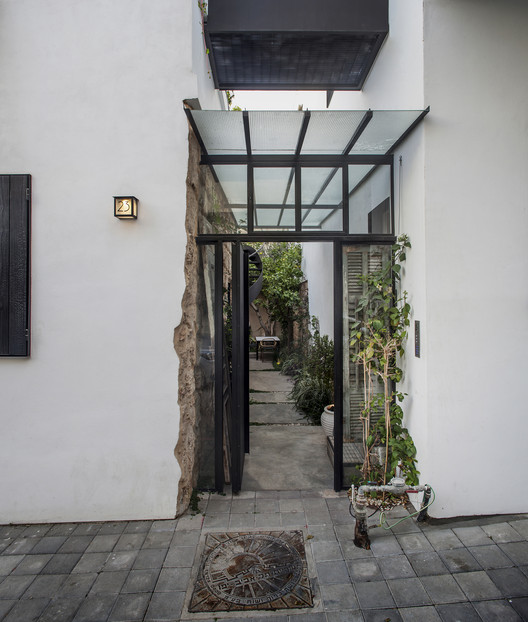 © Yoav Gurin © Yoav Gurin The center of those two buildings is the plant-full interior courtyard that can be seen and sensed from every corner of the house.  © Yoav Gurin © Yoav Gurin The rooms designed as a separate unit for each of the family members, including a living room, bedroom, kitchen and private bathroom.  © Yoav Gurin © Yoav Gurin From each room there is an exit to the inner courtyard or a balcony and to those who doesn't importance was given to vegetation and natural light inside the house.  1st floor plan 1st floor plan The black front windows at the facade are made of burnt wooden beams and emphasize the contrast between the city and the nature. 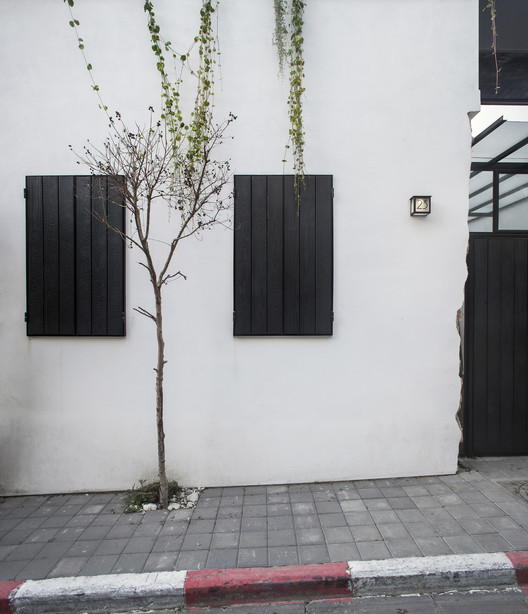 © Yoav Gurin © Yoav Gurin This posting includes an audio/video/photo media file: Download Now |
| Posted: 28 Nov 2018 01:00 PM PST .jpg?1543143170) © Chao Zhang © Chao Zhang
.jpg?1543143492) © Chao Zhang © Chao Zhang .jpg?1543143455) © Chao Zhang © Chao Zhang Text description provided by the architects. The Other Place is a creative guesthouse by the Li River in Pingle County, Guilin, and Studio 10 has just finished the renovation of its Dream-and-Maze-themed guestrooms. .jpg?1543142785) © Chao Zhang © Chao Zhang .jpg?1543142745) © Chao Zhang © Chao Zhang Inspired by the works of M.C. Escher, the architect meant to create a mysterious, infinite and impossible space with the seamless transformation amongst 2D and 3D as well as Optical Illusion elements. .jpg?1543142580) © Chao Zhang © Chao Zhang .jpg?1543142603) © Chao Zhang © Chao Zhang Pale pink and white color palette renders the interior space serene and surreally fresh, far from the chaos of mundane daily life. All components from the reality world such as lighting fixtures and electronic appliances have been concealed behind a series of black-painted doors, maintaining the pristine, chimerical nature of the space. .jpg?1543142697) © Chao Zhang © Chao Zhang .jpg?1543142973) © Chao Zhang © Chao Zhang In the other forest-green-themed room, anti-gravitational stairs leads to golden doors, behind which there could be a trail leading to a secret forest - or some other unexpected findings that surprises you. .jpg?1543143278) © Chao Zhang © Chao Zhang .jpg?1543143338) © Chao Zhang © Chao Zhang This posting includes an audio/video/photo media file: Download Now |
| R&D Headquarters, TOYO Electric / JJP Architects & Planners Posted: 28 Nov 2018 01:00 PM PST  © Jeffrey Chang © Jeffrey Chang
 © Jeffrey Chang © Jeffrey Chang Text description provided by the architects. The project is located in Huiyang District with great location and ease of transportation. The client's business is on manufacturing and exporting of Christmas lighting products, with total exporting value ranks among the top 100 in Shenzhen areas. In completion, the facility is expecting to facilitate local economic growth and becoming the leader of the light industry in southern China.  © Jeffrey Chang © Jeffrey Chang 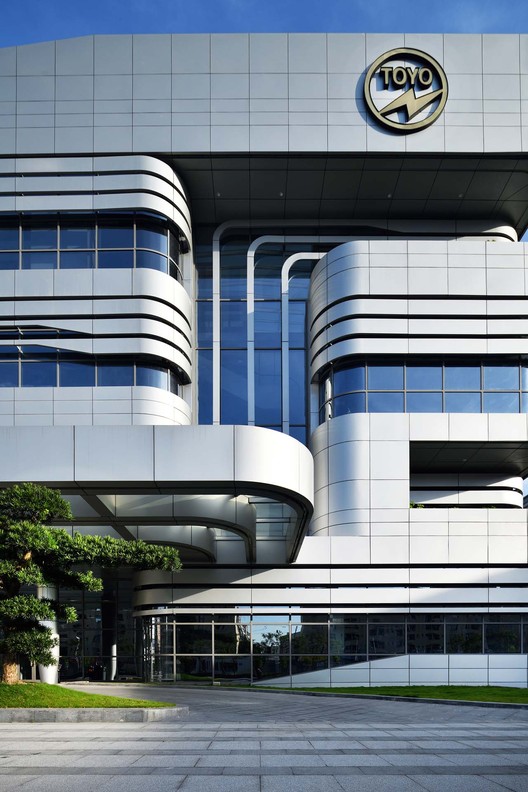 © Jeffrey Chang © Jeffrey Chang The main office building stands in the middle, flanked respectively by the cafeteria building and dormitory, that forms a welcoming plaza. The plaza bridges the public space outside the campus and shows a friendly attitude. The office building's concept reflects on the client's product, Christmas string illumination.  Analysis Diagram Analysis Diagram The design morphology displays a flowing louvre system escalates from the landscape to the canopy and then flows the entire building envelop to not only creates a diverse shape of balconies based on the user's needs but implies the structure of lighting ornaments and avoids sunlight exposure.  © Jeffrey Chang © Jeffrey Chang The interior lighting automatically adjusts in accordance with daylight to symbolize a beacon of Huizhou all day long.  © Jeffrey Chang © Jeffrey Chang 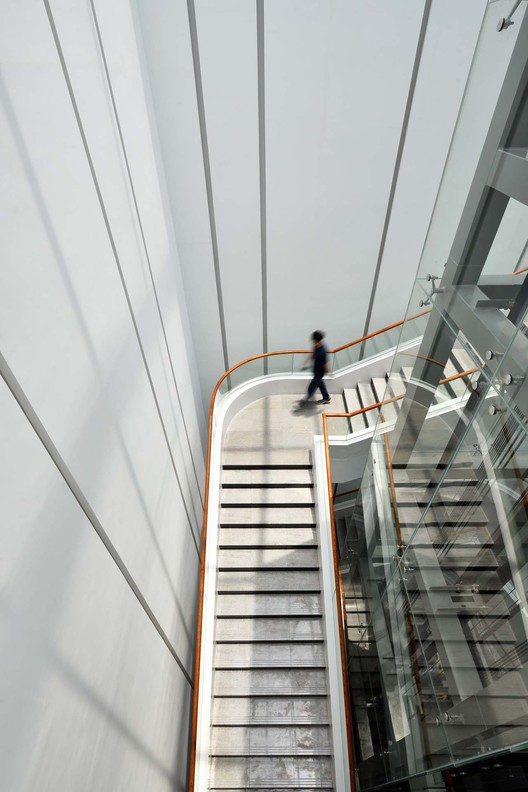 © Jeffrey Chang © Jeffrey Chang The campus consists of 2 dormitories, 4 fabrication plants, 4 warehouses, and affiliated facilities. The layout not only takes advantages of the local climate and transportation but expedites the production process and create a coherent environment for the staff.  © Jeffrey Chang © Jeffrey Chang The colored seasonal plantings fashion the context of the campus landscape to complete a sustainable campus, which communicates with the surrounding environment in a warm and relaxed atmosphere. Together they exemplified a new industrial era where industry/environment/society coexist for mutual benefit.  © Jeffrey Chang © Jeffrey Chang This posting includes an audio/video/photo media file: Download Now |
| Posted: 28 Nov 2018 12:00 PM PST 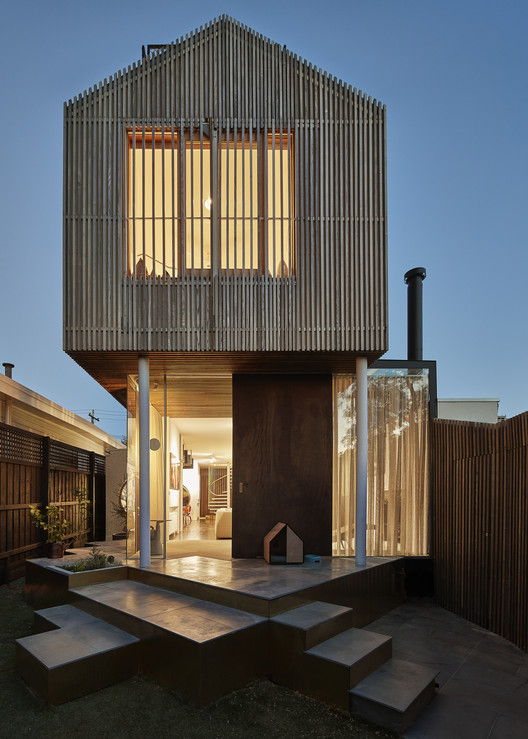 © Peter Bennetts © Peter Bennetts
 © Peter Bennetts © Peter Bennetts Text description provided by the architects. This renovation and addition transforms a Victorian cottage into a light filled showcase home for the Builder client. Distinct connections, materials and forms separate major elements within the house, while dissolving the additional mass externally to create an expansive and richly detailed experience.  © Peter Bennetts © Peter Bennetts Designed to use rich materials and distinct formal gestures to invert and highlight existing typologies this project evolved from a core concept of separation of elements.  © Peter Bennetts © Peter Bennetts  Drawing Drawing  © Peter Bennetts © Peter Bennetts The original 1887 cottage was an important design element to be incorporated into the new home. Retaining as much of the original design as possible preserved some of the project's history. The upper floor is designed to float above the original house. Internally glass walkways and externally timber cladding with vertical battens soften and dissolve the form. The cladding and large rear gum tree also act as shading devices and create shadow patterns from the natural light entering the house as the sun moves during the day. A large spiral staircase distinctly separates the new upstairs bedroom and bathroom spaces from the living zone. 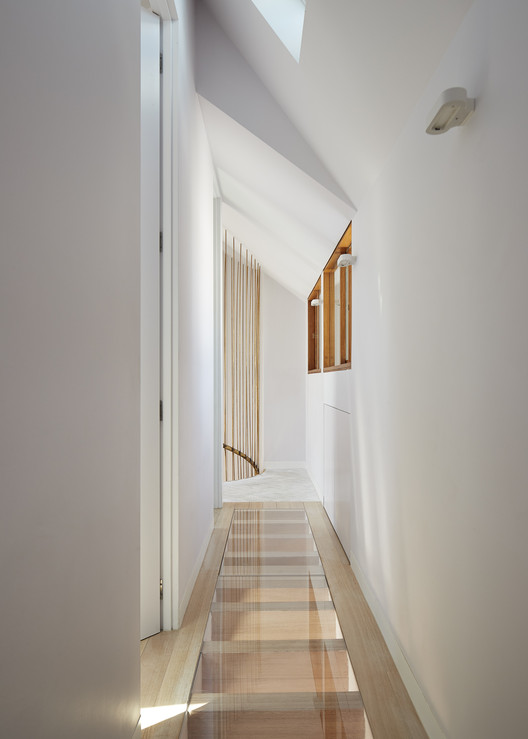 © Peter Bennetts © Peter Bennetts The rear of the property faces onto a playground reserve. A mirrored back fence was designed to acknowledge and allow the more public façade of the project to be interacted with. The mirrored surface visually extends the parkland and provides a playful feature for locals to enjoy. Embracing the public and existing context of this site was central to the design  © Peter Bennetts © Peter Bennetts Despite no heritage overlay in the area most of the houses have remained sympathetic to the original Victorian cottages lining the street. The dissolving nature of the addition's spaced timber-batten façade and hip roof provides a sympathetic response to existing neighbourhood conditions. At rear the staggered diamond shaped back fence posts allows the adjacent park into the garden while from the park the mirrored side of the post visually extends the open space beneath the floating upper storey of the house.  © Peter Bennetts © Peter Bennetts A showcase home for a builder's family, the brief included means for Oreo, the dog, to have maximum yard space without running through the house and the rest of the family required a home that flowed, increased their living area and separated their sleeping zones. The clients wanted the house to have moments of joy, which are achieved by rich material and light interplays, both within the home and with the rear park interaction. And Oreo has passage under the glass-cantilevered floor along the side of the house - allowing him to run freely from front to back yard.  © Peter Bennetts © Peter Bennetts This posting includes an audio/video/photo media file: Download Now |
| Posted: 28 Nov 2018 11:00 AM PST  © Tom Kessler © Tom Kessler
 © Tom Kessler © Tom Kessler Text description provided by the architects. Just off Historic Benson's main business strip in Omaha, Nebraska sat a 70-year-old building stained with oil and grease. Originally built as an auto body repair shop, the derelict warehouse sat vacant for many years.  © Tom Kessler © Tom Kessler  Floor plan Floor plan  © Tom Kessler © Tom Kessler TACKarchitects purchased the building after growing for six years in a startup incubator space in Omaha's North Downtown. The architects acted as owner, architect, and developer, moving their practice into the structure along with two additional tenants.  © Tom Kessler © Tom Kessler  Axonometry 03 Axonometry 03 TACKarchitects brings a professional office hub to what is largely an entertainment-centric commercial district, consisting of breweries, beer gardens, restaurants, and art galleries. The move not only displays maturation and growth of the firm, but also demonstrates a strong stride for revitalizing a historic neighborhood.  Axonometry 08 Axonometry 08 The restoration and design of the building is achieved through minimal adaptations of the existing structure. All the unnecessary elements from the building were removed so that the existing structure could be restored with a corn cob blaster. The design decisions resulted in a contemporary space that references the industrial programs of the building's historic past.  © Tom Kessler © Tom Kessler This posting includes an audio/video/photo media file: Download Now |
| Suntrap / Anderson Architecture Posted: 28 Nov 2018 09:00 AM PST  © Nick Bowers © Nick Bowers
 © Nick Bowers © Nick Bowers Text description provided by the architects. A home's liveability begins and ends with its orientation. For this heritage home in the inner western suburb of Lewisham, south-facing living quarters meant the family spent most of their time in cold, dimly lit rooms. Not much fun. But we had a plan, and one that resulted in a doubling of thermal efficiency in this part of the home from 3.2 to 6.4 stars!  © Nick Bowers © Nick Bowers With a growing family, including a four-legged friend, more space and improved connection with the backyard was a must, but thermal performance would be central to improved comfort. To bring in light and warmth, we proposed the demolition of an old addition and a careful redesign of the new. We knew we wanted to maximise budget and impact for the client, so we reduced the number of additional bedrooms (waste not, want not). To balance this, we dedicated a modest first floor addition to a more expansive parents' bedroom with ensuite.  © Nick Bowers © Nick Bowers  Ground floor plan Ground floor plan  © Nick Bowers © Nick Bowers  1st floor plan 1st floor plan But our key move was to introduce an internal courtyard. We opened the heart of the home to the sun, where strategically placed ecofriendly concrete walls and hydronic heated flooring brought much-needed heat gain to cold zones. New awnings let in winter sun and we specified heavily insulated prefabricated wall and roof panels, and double-glazed windows, to help maintain comfortable indoor temperatures.  © Nick Bowers © Nick Bowers The kitchen, dining and living are now warm in every sense.Reclaimed spotted gum flooring from the old addition we repurposed in cupboard faces and in a timber-lined ceiling above the kitchen. Our gorgeous,cantilevered stair detail adds a sculptural element alongside the courtyard, but it also lets in beautiful morning sun, warming breakfasters' backs as they sit at the kitchen bench.  © Nick Bowers © Nick Bowers Bricks from the old kitchen were repurposed as another strategic thermal mass wall in thebackyard. This doubles as a screen for a 1400L tank that supplies ample rainwater for the newly landscaped garden.A horticulturalist captured the clients' love of Australian native plantshere in a design that promotes birdlife and other local fauna. The theme continues into the internal courtyard where the blackened trunks of the iconic Xanthorrhoeagrass trees echo our choice of blackened timber cladding.  © Nick Bowers © Nick Bowers Of course the lesson in all of this is eco friendly architecture and heritage homes are the perfect bedfellows. And The Suntrap is one lovely, warm bed. This posting includes an audio/video/photo media file: Download Now |
| Haysom Ward Miller's Lochside House Named RIBA House of the Year 2018 Posted: 28 Nov 2018 09:00 AM PST _Client.jpg?1543427238) Lochside House. Image © Richard Fraser Lochside House. Image © Richard Fraser Haysom Ward Millar's Lochside House in the West Highlands has been named RIBA House of the Year 2018. The annual accolade is given by the Royal Institute of British Architects (RIBA) to the UK's best new architect-designed house. Lochside House was revealed as the winner in the final episode of a special Channel 4 series Grand Designs: House of the Year. The award-winning project was designed as a modest, sustainable home for a ceramic artist on the edge of a Scottish lake.  Lochside House. Image © Richard Fraser Lochside House. Image © Richard Fraser The house is formed of three buildings huddled together and clad in burnt Scottish larch, protected by a traditional drystone wall. The house is completely off-grid: all energy comes from the sun and water is pulled up from a borehole. Inside, the rooms are made with a pared-back aesthetic. Walls are lined in white oiled timber, surfaces are skimmed with a rough textured plaster and large windows at varying heights capture stunning views. Inside, the spaces merge with the artist owner's art collection. _Richard_Fraser.jpg?1543427168) Lochside House. Image © Richard Fraser Lochside House. Image © Richard Fraser RIBA President Ben Derbyshire said that, "by containing its scale, sensitively positioning the crop of buildings on a promontory around established trees, and making use of local materials, HaysomWardMiller have created a home which perfectly responds to its exposed, unique location. Every detail has been fine-tuned to create an exceptional home and studio that meets the needs and wishes of its artist owner. Lochside House is the perfect addition to this dream landscape." The house was chosen for its client-architect relationship, which resulted in "an exceptional house that has a rich conversation with the natural environment." _Richard_Fraser.jpg?1543427093) Lochside House. Image © Richard Fraser Lochside House. Image © Richard Fraser _Richard_Fraser.jpg?1543427073) Lochside House. Image © Richard Fraser Lochside House. Image © Richard Fraser Tom Miller of HaysomWardMiller, said that: "To build a good, energy-efficient house here wasn't straightforward. It was only possible because we had a client with the uncompromising determination and vision to keep pushing us to achieve our best, and a contractor's team for whom we have enormous respect - they seemed to thrive on the unique challenges posed by building on such an exposed and inaccessible site." The Makers House by Liddicoat & Goldhill was the seventh and final home shortlisted for the RIBA House of the Year. The full shortlist for the RIBA House of the Year 2018 is:
RIBA House of the Year 2018 is sponsored by Forterra. This posting includes an audio/video/photo media file: Download Now |
| Flagship Branch Bank DSK / DA architects Posted: 28 Nov 2018 08:00 AM PST  © Minko Minev © Minko Minev
 © Minko Minev © Minko Minev Text description provided by the architects. Looking for a different perception of the environment, typical for a bank branch, our studio developed a detailed concept for the renovation of DSK Bank network. We completed the pilot design of a centrally located bank office, opened for customers at the beginning of 2017.  © Minko Minev © Minko Minev
 © Minko Minev © Minko Minev We moved the functional units from their common location in the center of the office to its periphery, in order to make room for a spacious and open common area. The function of the separate units defines the dynamics of the surrounding walls, bringing the interior to life and integrating aesthetics and usability. 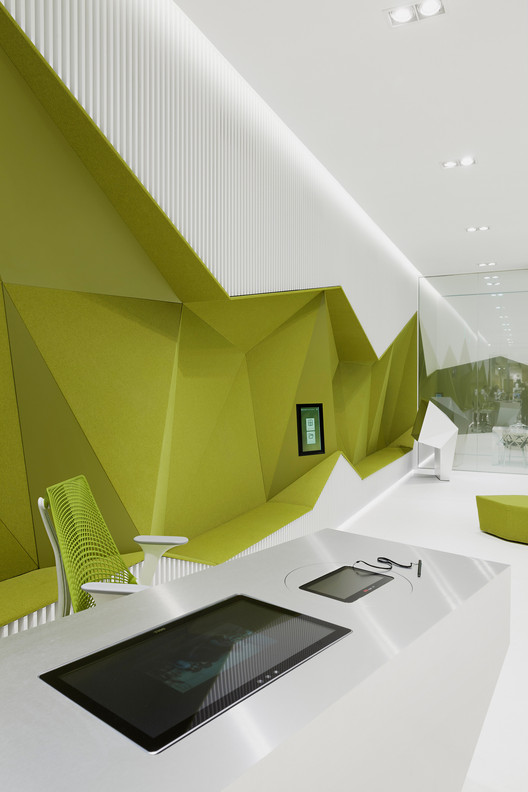 © Minko Minev © Minko Minev Both long sides of the surrounding walls are covered with white vertical louvers, intersected by a dynamic green strip. The strip forms concave spaces with diverse height and depth.
Being a public space with orthogonal shape, flat and solid floor and ceiling, the branch required more thoughtful treatment of the walls in order to achieve acoustic comfort. The vertical louvers and the variously oriented upholstered panels contribute to the good acoustics.  Gif - Front. Image Courtesy of DA architects Gif - Front. Image Courtesy of DA architects  Plan Plan  © Minko Minev © Minko Minev The bank's branch is an open space that combines consultants' desks, waiting areas and a few self-service or informational devices. Consultants' desks are designed as blocks, shaped by stainless steel panels, styled as the polygonal green strip, which makes them look like they are extracted from it.
The video consulting module is also designed as a solid volume that revolves around a vertical axis, in order to be suitable for disabled people.
The simple and definitive design of the completed bank office contrasts the ornate and multicolor surrounding of the shopping mall. It distinguishes it and attracts the attention of passers-by. The balanced use of materials and textures, the unified modeling language and the stark geometrical and color accent define a distinct, notable, and contemporary space. 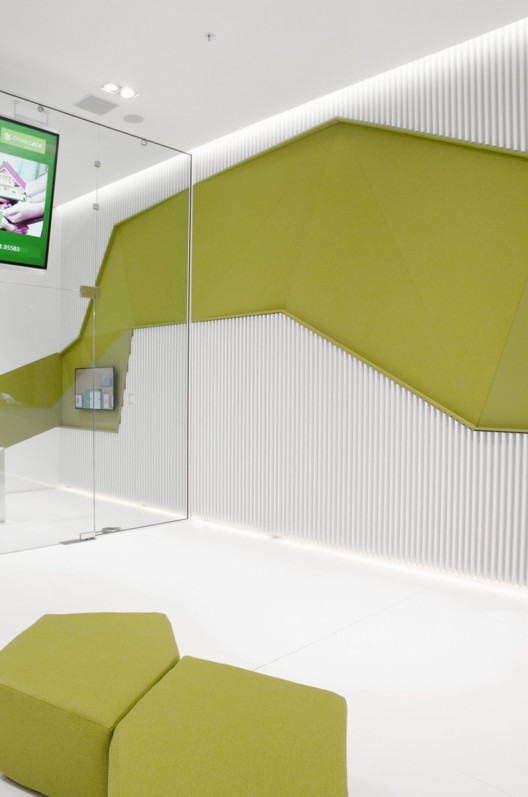 Gif - Doors. Image Courtesy of DA architects Gif - Doors. Image Courtesy of DA architects This posting includes an audio/video/photo media file: Download Now |
| The 2018 World Architecture Festival Announces the Day One Winners Posted: 28 Nov 2018 07:00 AM PST  Heatherwick Studio - Zeitz MOCAA © Iwan Baan. Image © Iwan Baan Heatherwick Studio - Zeitz MOCAA © Iwan Baan. Image © Iwan Baan Following an extensive day of presentations, panels, critiques, and talks The World Architecture Festival (WAF) has announced the Day 1 category winners in their 2018 programming. Winners are recognized in over 35 categories over the first two days of the conference, which culminates with the announcement of the World Building of the Year 2018 on the third and final day of the conference. While still early days, the world's largest architectural award program, the WAF Awards is poised for its biggest year yet, with a total of 535 shortlisted projects from 57 countries across the world. The finalist projects will be selected live at the festival by a Super Jury made up of jury chair Nathalie de Vries, Director & Co-founder of MVRDV; Lesley Lokko, Head of the Graduate School of Architecture at the University of Johannesburg; Manuelle Gautrand, Founder of Manuelle Gautrand Architecture; Li Xiaodong, Founder of Atelier Li Xiaodong; and Frederick Cooper Llosa, Founder and Senior Partner of COOPER, GRAÑA, NICOLINI, Arquitectos. The full shortlist of projects can be viewed here, and see which built and future projects took home the first day's awards after the break. INSIDE AwardsCategory: Health Shirley Ryan AbilityLab by HDR + Gensler + Clive Wilkinson Architects (Image credit:Michael Moran. Photo © Dan Schwalm Shirley Ryan AbilityLab by HDR + Gensler + Clive Wilkinson Architects (Image credit:Michael Moran. Photo © Dan Schwalm Winner: Shirley Ryan AbilityLab by HDR + Gensler + Clive Wilkinson Architects Category: Education B Campus by AIM Architecture. Photo © Marc Goodwin B Campus by AIM Architecture. Photo © Marc Goodwin Winner: B Campus by AIM Architecture Category: Office The Department Store by Squire and Partners. Photo © James Jones The Department Store by Squire and Partners. Photo © James Jones Winner: The Department Store by Squire and Partners Highly Commended (Joint): Logistic Republic Automation Warehouse Between Machine, Between Human by JC Architecture Highly Commended (Joint): Frasers Property Australia Head Office by BVN Category: Retail BLANK by Hangzhou AN Interior Design Co. Photo © Yujie Liu BLANK by Hangzhou AN Interior Design Co. Photo © Yujie Liu Winner: BLANK by Hangzhou AN Interior Design Co Highly Commended: NikeLab CHI by RUFprojec Completed BuildingsCategory: Civic and Community CHROFI with McGregor Coxall - Maitland Riverlink © Simon Wood. Image CHROFI with McGregor Coxall - Maitland Riverlink © Simon Wood. Image Winner: CHROFI with McGregor Coxall - Maitland Riverlink, Maitland, Australia Category: Health-Future Projects and SportWinner: Allford Hall Monaghan Morris - The Alder Centre, Liverpool, United Kingdom Category: CultureWinner: Conrad Gargett - The Piano Mill, Stanthorpe, Australia Category: Display Arkitema Architects - Hammershus Visitors Centre © Jens Markus Lindhe. Image Arkitema Architects - Hammershus Visitors Centre © Jens Markus Lindhe. Image Winner: Arkitema Architects - Hammershus Visitors Centre, Allinge, Denmark Category: HouseWinner: David Leech Architects - A house in a garden - 81 Hollybrook Grove, Dublin, Ireland Category: Housing, Small ScaleWinner: Allford Hall Monaghan Morris - Weston Street, London, United Kingdom Category: New & Old Heatherwick Studio - Zeitz MOCAA © Iwan Baan Heatherwick Studio - Zeitz MOCAA © Iwan Baan Winner: Heatherwick Studio - Zeitz MOCAA, Cape Town, South Africa Category: OfficeWinner: INNOCAD Architecture - C&P Corporate Headquarters, Graz, Austria Category: Production, Energy & Recycling Parviainen Architects - Länsisalmi Power Station © Mika Huisman - Decopic Parviainen Architects - Länsisalmi Power Station © Mika Huisman - Decopic Winner: Parviainen Architects - Länsisalmi Power Station, Vantaa, Finland Future ProjectsCategory: CivicWinner: BAAD Studio - The Sunken Shrine of Our Lady of Lourdes of Cabetican, Bacolor, Philippines Category: Competition EntriesWinner: Nextoffice - Sadra Civic Center, Sadra, Iran Category: Experimental KANVA - Imago, Montreal, Canada. Image © KANVA KANVA - Imago, Montreal, Canada. Image © KANVA Winner: KANVA - Imago, Montreal, Canada Category: InfrastructureWinner: Monk Mackenzie – Thiruvalluvar, Kanyakumari, India Category: Leisure-Led DevelopmentWinner: BIG-Bjarke Ingels Group - Audemars Piguet Hôtel des Horlogers, Le Brassus, Switzerland Category: Office 3XN Architects - Olympic House - International Olympic Comittee HQ, Lausanne, Switzerland. Image © 3XN Forbes Massie 3XN Architects - Olympic House - International Olympic Comittee HQ, Lausanne, Switzerland. Image © 3XN Forbes Massie Winner: 3XN Architects - Olympic House - International Olympic Comittee HQ, Lausanne, Switzerland
This posting includes an audio/video/photo media file: Download Now |
| Hotel Monville / ACDF Architecture Posted: 28 Nov 2018 06:00 AM PST  © Adrien Williams © Adrien Williams
 © Adrien Williams © Adrien Williams Text description provided by the architects. ACDF Architecture, a dynamic and experienced architectural firm, is proud to unveil the distinct sophistication of Hôtel Monville, the first in a collection of future properties envisioned by the owners of Old Montreal's Hotel Gault. Opened in March 2018, Hôtel Monville exudes Montreal chic, with a balanced blend of contemporary style and historic charm that embodies the essence of its urban surroundings.  © Adrien Williams © Adrien Williams "We set out to create a property that captures the local character and high-end experience of Hotel Gault, but with design elements uniquely developed for and aligned with the Monville concept," explains Maxime-Alexis Frappier. "We have delivered that vision, providing Hôtel Monville visitors and guests with upscale experiences throughout the property."  © Adrien Williams © Adrien Williams Distinction amongst distinguished company  © Adrien Williams © Adrien Williams The vestibule entrance expands into a triple-height lobby, framed by stacked volumes of warm oak and cathedral-style white columns whose lamp-lit bases add ambiance to Hôtel Monville's inviting public spaces. Tartan sofas and leather banquettes encourage social interactions in an area framed by vintage black and white photos of Montreal life, forming part of a customized mural commissioned from local artist Valerie Jodoin Keating.  © Adrien Williams © Adrien Williams The vibe of Hôtel Monville begins in its lobby. Beyond the traditional spaces of a functioning hotel, a DJ booth crafted into the surrounding oak motif sets the mood for an adjoining lobby bar featuring white terrazzo tables and countertops, impeccably highlighted with brass detailing. The Gourmet Monville Café completes the entrance level's enticing offerings, with an array of local cuisine that transitions from day to night.  © Adrien Williams © Adrien Williams "Hôtel Monville was designed to be a destination in its own right, with plenty of functional spaces away from the guest suites, including the vibrant lobby, meeting rooms, a library and a spacious rooftop terrace," says Maxime-Alexis Frappier. "We have created an ambiance where people can gather together to meet, have a drink or enjoy a meal in the heart of vibrant local activity."  © Adrien Williams © Adrien Williams Comfort and connectivity  © Adrien Williams © Adrien Williams In addition to modern and sleek aesthetics, Hôtel Monville is designed for 21st century connectivity, incorporating state-of-the-art compatibilities and technology offerings that enhance the guest experience. Advanced technologies include online and electronic kiosk check-in options and Smart TVs that sync with personal devices. Additionally, Hôtel Monville is Canada's first property offering autonomous robot room service delivery courtesy of a robot designed by California firm, Savioke, which carries food orders directly to guest rooms in record time.  © Adrien Williams © Adrien Williams Finishing touches to the client's vision of infusing local life, history, culture and vibrancy into Hôtel Monville include lighting from Montreal studio Lambert & Fils, all-natural bath products from Quebec company Oneka and staff uniforms designed by Canadian brand Frank & Oak.  © Adrien Williams © Adrien Williams This posting includes an audio/video/photo media file: Download Now |
| BIG, Gensler, and Field Operations Reveal Design for Oakland Athletics Baseball Stadium Posted: 28 Nov 2018 05:00 AM PST  Oakland Baseball Stadium. Image Courtesy of Oakland Athletics / Bjarke Ingels Group Oakland Baseball Stadium. Image Courtesy of Oakland Athletics / Bjarke Ingels Group Bjarke Ingels Group, James Corner Field Operations, and Gensler have released new renderings of the new Oakland Athletics baseball stadium and surrounding development. The new stadium will replace the Oakland A's existing 51-year-old Oakland-Alameda County Coliseum, which the A's share with the Oakland Raiders football team. The mega-ballpark includes a waterfront "jewel box" stadium at Howard Terminal and would turn the current Coliseum site into a tech and housing hub.  Oakland Baseball Stadium. Image Courtesy of Oakland Athletics / Bjarke Ingels Group Oakland Baseball Stadium. Image Courtesy of Oakland Athletics / Bjarke Ingels Group The news comes following a period of speculation for the A's, with HOK, Sasaki, Snohetta and Studio T-Square all linked to the potential development. A's President Dave Kaval said that the A's control of both the Howard Terminal site and the Coliseum site in East Oakland is essential to delivering a "100 percent privately built ballpark." Kaval said turning portions of the Coliseum site into a park would create a public amenity and avoid shoring the site to protect it against rising sea levels.
 Oakland Baseball Stadium. Image Courtesy of Oakland Athletics / Bjarke Ingels Group Oakland Baseball Stadium. Image Courtesy of Oakland Athletics / Bjarke Ingels Group  Oakland Baseball Stadium. Image Courtesy of Oakland Athletics / Bjarke Ingels Group Oakland Baseball Stadium. Image Courtesy of Oakland Athletics / Bjarke Ingels Group The ballpark design is situated amid wedge-shaped high-rises looking directly down on the playing field. The stadium would include a publicly accessible rooftop park and an aerial gondola to shuttle fans over Interstate 880 and the railroad tracks to Jack London Square.
News via San Francisco Chronicle This posting includes an audio/video/photo media file: Download Now |
| Casa Santísimo / JJRR/Arquitectura + AREA Posted: 28 Nov 2018 04:00 AM PST  © Jaime Navarro © Jaime Navarro
 © Jaime Navarro © Jaime Navarro Text description provided by the architects. It is an intervention and extension of a house in the residential area of San Angel at south of Mexico City.  © Jaime Navarro © Jaime Navarro The challenge in this project is to preserve the essence of the original house, being a house with a large central courtyard with a traditional style of colonial hacienda characteristic of the houses in San Angel. In turn complement the architectural program with a contemporary touch in such a way that respect to 100% the essence and style of the original house. To achieve this result, we think of materials such as wood, flattened whitewash, volcanic stone, glass, as well as giving importance to vegetation; with the intention of differentiating the new part of the original part of the house achieving a good dialogue between both.  © Jaime Navarro © Jaime Navarro  Section Section  © Jaime Navarro © Jaime Navarro On the ground floor we find the living-dining room between the garden and the central courtyard, looking for the greatest possible transparency between them causing a cross ventilation. In the same way it was possible to play with the interior atmosphere and the exterior, in such a way that the garden and the central patio are the main elements.  © Jaime Navarro © Jaime Navarro Around the central courtyard is the game room, studio, family-room, kitchen and laundry, all with direct access and views to the central courtyard.  © Jaime Navarro © Jaime Navarro In the first level we find the most private areas, 3 bedrooms with bathroom-dressing room and terrace each and a more intimate family as well as a gym.  © Jaime Navarro © Jaime Navarro In the basement floor we find the parking lot for 8 cars, 2 service rooms, security booth and the main access to the house in a very independent way to the services. This posting includes an audio/video/photo media file: Download Now |
| A First Look at the US Pavilion for Expo 2020 Dubai, Designed by Fentress Posted: 28 Nov 2018 02:20 AM PST  Courtesy of Fentress Architects Courtesy of Fentress Architects The design of the USA Pavilion for the Expo 2020 Dubai has been revealed, designed by Curtis W. Fentress and Fentress Architects. Destined to represent more than 325million Americans, the pavilion seeks to "provide a unique platform for [the United States] to come together to showcase the very best of [their] cultural and commercial achievements." The pavilion is to be circular in form, with "slants fashioned to project a sensation of movement, making the viewer feel like the building itself is in motion." The pavilion's interior will showcase American innovation and technology, including the premiere of the Virgin Hyperloop One ride experience.  Courtesy of Fentress Architects Courtesy of Fentress Architects Inside the pavilion, an immersive cutting-edge interactive experience has been designed by George P. Johnson Experience Marketing, seeking to "bring to life the stories of how the most inspiring American mobility innovations are improving the lives of individuals all over the world.  Courtesy of Fentress Architects Courtesy of Fentress Architects
 Courtesy of Fentress Architects Courtesy of Fentress Architects Dubai will be the first Middle Eastern city to host a World Fair in the exhibition's 160-year history, with more than 25 million people expected to attend the Expo throughout its six-month duration from October 2020 to April 2021. The World Fair is the third largest global event after the Olympics and FIFA World Cup.  Courtesy of Fentress Architects Courtesy of Fentress Architects The Expo 2020 will also feature a UK Pavilion designed by Es Devlin, a UAE Pavilion designed by Santiago Calatrava, a Luxembourg Pavilion by Metaform and The Space Factory, a Sustainability Pavilion by Grimshaw, and themed pavilions by Foster + Partners and Bjarke Ingels Group.  Courtesy of Fentress Architects Courtesy of Fentress Architects News via: Fentress Architects This posting includes an audio/video/photo media file: Download Now |
| Weave / Spridd Etat arkitekter Posted: 28 Nov 2018 02:00 AM PST  © Anders Fredriksén © Anders Fredriksén
 © Anders Fredriksén © Anders Fredriksén Text description provided by the architects. Spridd and Etat´s award-winning design for the residential building in Norrköping is now realized. The project "Weave" won the international competition MIPIM Architectural Review Future Project Award in 2013 in the prestigious category for residential houses.  Floor Plan 1 Floor Plan 1  © Anders Fredriksén © Anders Fredriksén "Weave" has commercial spaces on the ground floor and underground garage. It is centrally located in Norrköping's historic industrial inner-city landscape. The building completes a triangular city block in the dense urban landscape where three streets meet. The area was originally used by the textile industry and is now gradually converted to house offices, educational and cultural institutions, restaurants and housing. "Weave" is part of this urban transformation.  © Anders Fredriksén © Anders Fredriksén The apartments are of a different character: the ground floor apartment connect directly to the street and can be used for small-scale commercial activities or an atelier space combined with accommodation; apartments on the upper floors vary in suitable size for students as well as seniors and families with children. On the communal rooftop terrace, each apartment has its own parcel with views of the cityscape.  © Anders Fredriksén © Anders Fredriksén The architecture interprets certain characteristic themes of the industrial landscape such as large windows, local towers, repetitive and rational windows. The building's facade is made of precast concrete with an undulating surface that gives a textile character to the facade; windows are done in gold anodized aluminum.  Section Section  Courtesy of Erik Törnkvist Courtesy of Erik Törnkvist ABOUT SPRIDD  © Anders Fredriksén © Anders Fredriksén This posting includes an audio/video/photo media file: Download Now |
| You are subscribed to email updates from ArchDaily. To stop receiving these emails, you may unsubscribe now. | Email delivery powered by Google |
| Google, 1600 Amphitheatre Parkway, Mountain View, CA 94043, United States | |
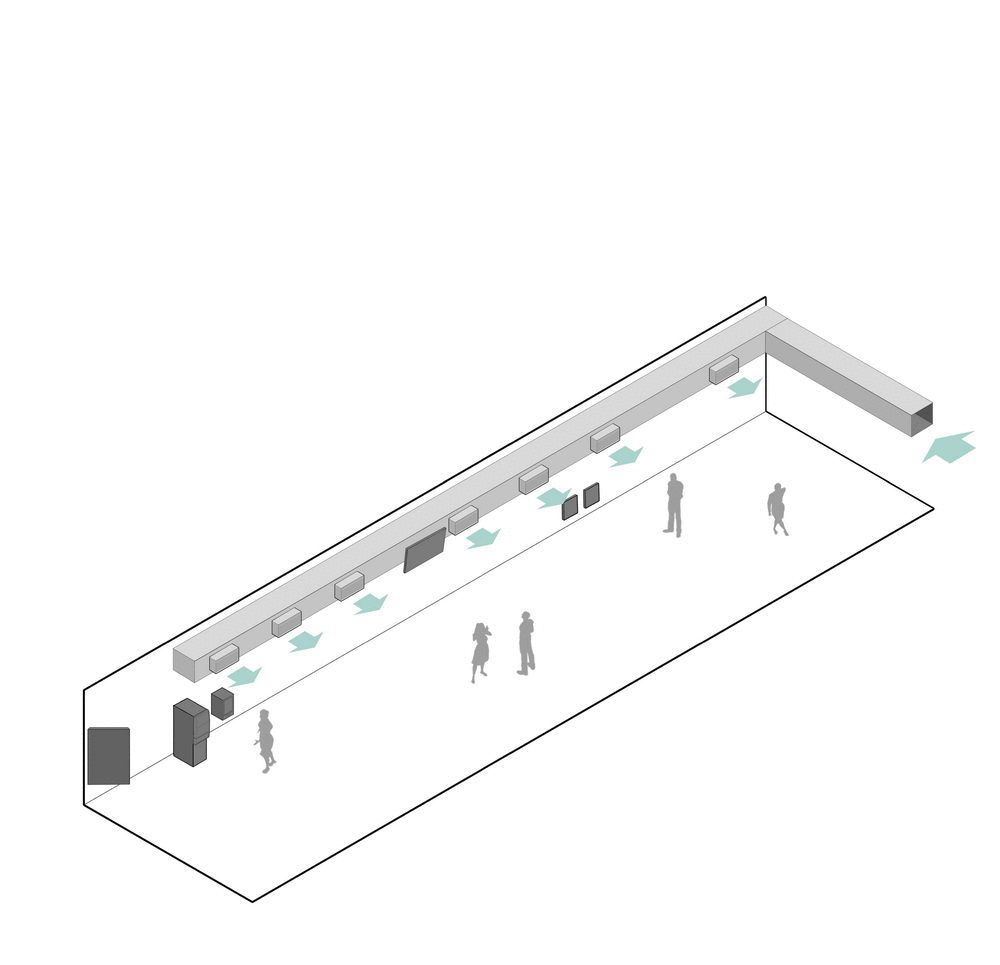


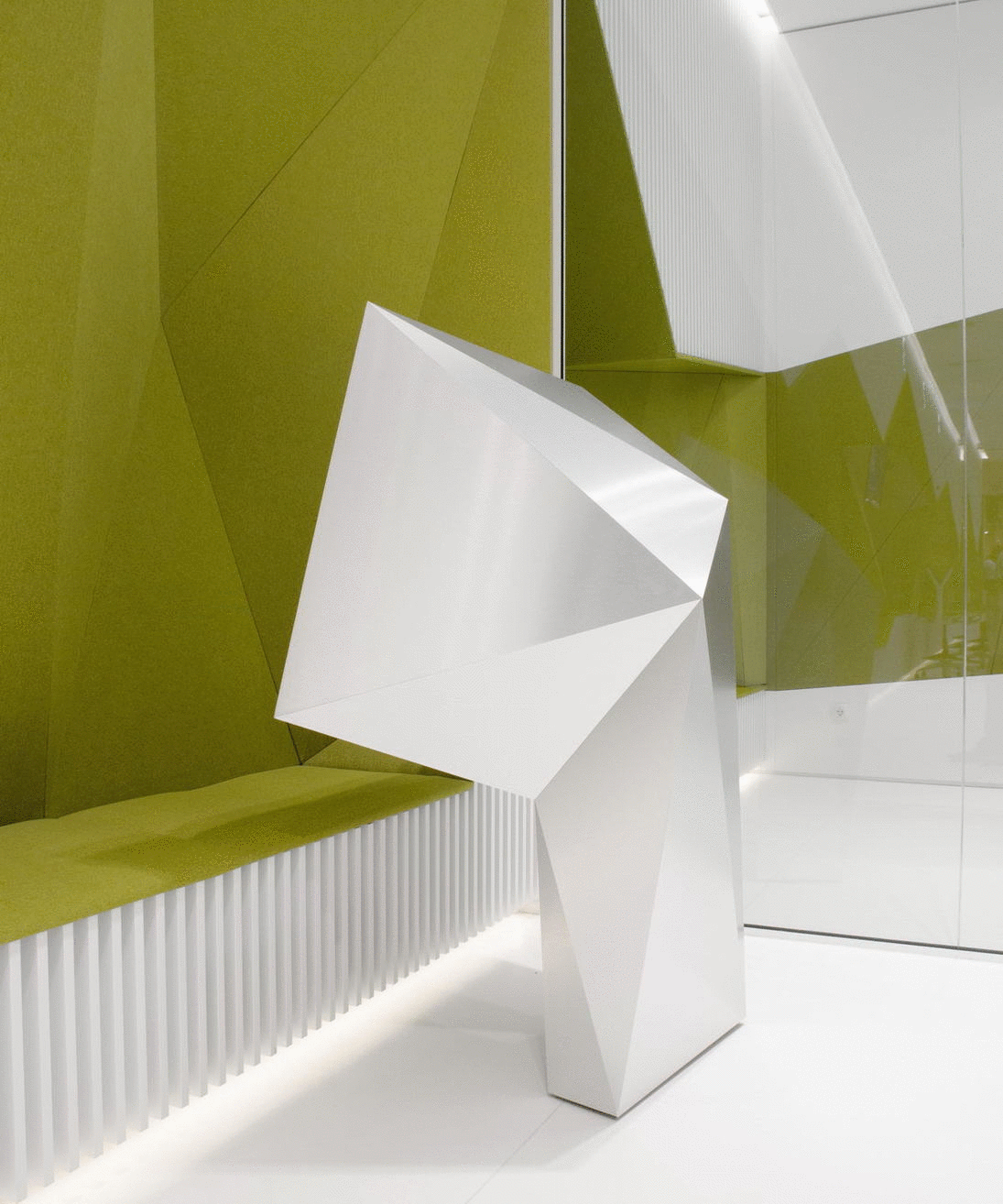
Nema komentara:
Objavi komentar